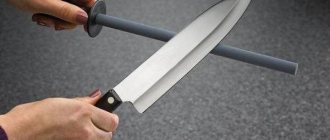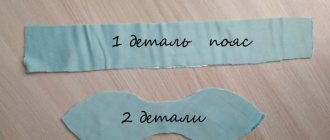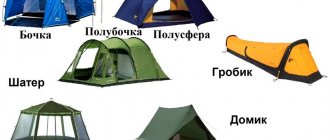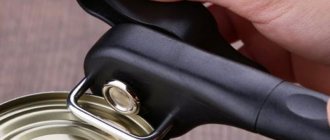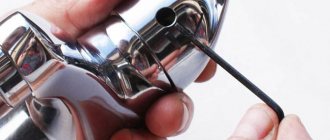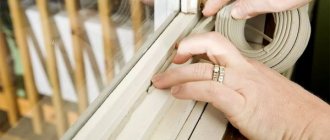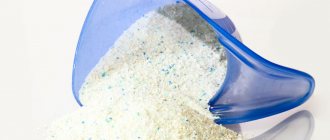Sharpening a knife blade to razor sharpness is a simple matter. Following the sequence of actions, relying on your own acquired experience, ensures a certain pleasure from the result obtained. To do this, it is enough to have a sharpening station or a high-quality sharpener and know the rules for obtaining a high-quality sharpened blade, which are included in the instructions for these devices.
Types of knives and their purpose
Modern classification divides knives into the following categories:
- Combat. They are bladed weapons and are in service with the army as an addition to firearms. They are not intended for free sale and use.
- Tourist. Available for purchase, not prohibited from wearing, the handle and sheath are usually made of synthetic materials.
- Hunting. They have a varied form and purpose of use: work on cutting up hunted game, skinning, arranging a hunting area. Some types require permission to purchase and carry.
- Foldable or collapsible. A very common type, loved by all age categories of people. As the name suggests, the blade folds and the cutting edge fits into the handle. Some types are equipped with clips for attaching to a belt or pocket.
- Multitool A folding multifunctional knife with a set of tools - indispensable for travel and repairs. The standard sample includes: a small and large blade, pliers, screwdrivers, wrenches, a ruler, a hook, and scissors.
- Special purpose. A tool used in certain branches of human activity: medicine (scalpel), diving, Ministry of Emergency Situations, gardening.
- Campers or bivouacs. They are quite large in size and weight. Designed for setting up a tourist camp and clearing the area of the recreation area from bushes and small trees. An example is a machete or kukri. In practice, they easily replace an ax, but at the same time, they remain knives.
- Mark or sports knife for throwing. It is all-metal, without a cutting edge, and is designed to hit a target with a hand throw.
- Kitchen. Used for cooking, they come in a variety of shapes, sizes, thicknesses and blade configurations.
- Dining rooms. They have a certain shape with a rounded tip of the blade, the main purpose is to make eating easier.
- For survival. Positioned as assistants in extreme conditions. They have a number of features: the presence of a compass, a hollow handle that can accommodate a survival kit (a lighter, a fishing line with a sinker and a hook, a thread and a needle, an antiseptic, an antibiotic).
Rules for sharpening knives
The knife is the oldest invention of mankind, a tool that cannot be replaced in everyday life and in human work. Thousands of years of use, modernization of the form and materials used, has led to the emergence of household items with different uses and purposes. When sharpening knives, pay attention to the following:
- You need to work starting with a larger abrasive.
- The last stage of grinding is used on stone with the finest fractions.
- Razor sharpness is provided by genuine leather and ceramics.
- The standard sharpening angle is 20º. The need for others is indicated by the manufacturer in the instructions. Typically, a larger one is required for rough work.
- The larger the angle, the more metal is removed.
- When sharpening the knife, hold the handle and the tip of the blade with both hands.
- To prevent overheating, wetting with water is performed.
3) Electric knife
0
Source:
You can use them. But normal ones cost from 10,000 rubles, and cheap ones... it’s easier to throw them away right away. they do not fulfill their function. Good electric sharpeners are suitable for food production (including catering kitchens), where iron tables are used or knives simply become dull often. He walked up, turned it on, ran it a couple of times, and went on cutting. This does not eliminate the need to use musat. The quality of sharpening greatly depends on the quality of the sharpener, and, accordingly, on the price. You don't need this at home. If you see something like the following picture, throw it away. It either doesn't work at all or pretends to work. With some cheap ones you can, of course, achieve a certain result... but it is downright modest or dubious. (I’m not talking about special gadgets such as grinders, tormeks and others - this is completely different, few people have them and their review will be in the next post.)
Rules for using a whetstone
To ensure the desired cutting qualities of the knife, the following recommendations should be taken into account:
- Soak the stone in water for 15 - 20 minutes;
- to work you need a table in a well-lit place or with a lamp;
- to prevent the stone from slipping and damaging the table covering, place a cloth or paper on the table;
- to visually determine the sharpening angle of the knife, the blade is applied to the sharpening stone;
- the blade being sharpened is directed away from you at the selected angle;
- with gentle pressure, a reciprocating movement is produced, simulating cutting off a thin film from a grindstone along its entire plane. In this case, the blade moves relative to the block from the handle to the tip and back;
- the selected sharpening angle is maintained during each stroke of the stone;
- the blade and stone are periodically moistened with water and cleaned;
- after 20 - 30 repetitions on both sides of the blade, the cutting edge is inspected. When sharpened with a razor, it is not visible to the naked eye;
- The sharpness of the blade is checked on a sheet of paper by cutting it from top to bottom. A sufficiently sharp blade cuts and does not tear paper.
Folk remedies for washing dishes - benefits, savings or a waste of time
Why does the blade become dull?
There are a number of factors that influence the process of dulling a cutting edge:
- Excessive force transmitted to the tool when cutting. This causes the blade to bend.
- Incorrect turning process.
- Cutting hard materials.
- Improper storage.
- Impacts against metal objects.
- Destruction of metal due to corrosion.
Blacksmiths do not recommend washing knives under hot water. This is due to the fact that the metal is affected by aggressive salts, which reduce the sharpness.
At what angle should knives be sharpened, and how to fix the knife when sharpening
The main conditions that determine the sharpening angles of the blade are the purpose and conditions of use of the blade. The smallest sharpening angle assumes the sharpest blade for thin cuts, as an example of a fillet cut. A larger angle of the sharpened blade is preferred when editing a chopping tool - an ax, a camp knife. When applying knowledge in practice, simply to obtain the desired sharpness and resistance to dullness of different tools, be sure to take into account the type of steel of the blade.
Having decided on the sharpening angle, hold the knife with one or two hands, pressing it against the abrasive. Holding with two hands occurs by the handle and the opposite part from the edge of the blade being sharpened, thus holding a tool with a long and wide cutting part. Control over the required fixation and compliance with the angle is visually tactile and acquired with experience.
The required angle for each tool used when sharpening the blade:
| No. n\n | Types of knife | Angle (degrees) |
| 1 | dining room | 55 — 60 |
| 2 | kitchen utility - household | 30 — 35 |
| 3 | professional kitchen | 25 — 30 |
| 4 | professional chef | 20 — 25 |
| 5 | professional for fish | 25 |
| 6 | professional for meat | 30 |
| 7 | vegetable | 35 |
| 8 | for root vegetables | 22 — 25 |
| 9 | meat deboning | 25 — 30 |
| 10 | sirloin | 10 — 15 |
| 11 | for chopping bones | 30 — 45 |
| 12 | folding - pocket | 20 — 25 |
| 13 | tourist - universal | 30 — 35 |
| 14 | tourist, camp knife | 40 — 45 |
| 15 | special purpose shoemaker | 30 — 40 |
| 16 | leather cutting knife | 20 — 25 |
| 17 | carpentry | 30 — 45 |
| 18 | camper - machete | 45 — 60 |
Methods for checking the blade tip
After carrying out the work, you need to check how sharp the blade is. Several methods are used for this.
On paper
Try to cut a sheet of paper while holding it with one hand. If you can do it without problems, the sharpening is good. A sharp blade will cut the sheet under its own weight.
On a tomato
Often the sharpness of kitchen blades is tested on tomatoes. If it is blunt, the vegetable will be crushed. You need to put it on the table in front of you, try to cut the tomato with the blade horizontally without holding it with your hand. A sharp blade will easily cut a vegetable.
Checking knife sharpening on tomatoes
Testing on hand hair
One of the testing methods that people often use after turning tools. To do this, the knife is pressed effortlessly against the skin of the hand. It should be easily passed through the hair. If the hairs are cut, the blade is sharp, suitable for various types of work.
Everyone uses knives. However, these tools become dull over time, making it impossible to work with them. To restore the sharpness of steel, you can use different devices. Taking into account the angles for different types of knives, you can carry out the work yourself.
Sharpening tools
There are many ways to sharpen, as well as devices used for this process. Let's look at the most popular ones. Among them the following are popular:
Sharpening stone
Natural whetstones are popular among professional sharpeners; when used correctly, they achieve the highest cutting quality of the tool being sharpened. Arkansas novaculite stone and Japanese water stone are favorites of natural stones. The price of such bars is high, although they are produced artificially in an industrial way. The wear of the stone is high, which is suitable for lens-shaped sharpening of blades. A beginner will need patience and perseverance, high qualifications to work with such stones:
- Diamond stones are a popular and very affordable material for turning any tool. They produce fine and coarse grains of different shapes and sizes. They are an excellent choice for a beginner. The price is budget-friendly, allowing you to have a set of stones in your arsenal for any need. The wear of the diamond stone is very low, the abrasive effect is strong, so control of the sharpened edge of the blade should be increased as much as possible. Used in most cases for initial processing of the cutting part and setting the sharpening angle.
- Ceramic whetstones are modern sharpening stones that combine the advantages of natural and diamond materials used by sharpeners. The main application is final finishing after working with a knife on a diamond abrasive. They have little wear and allow to achieve high quality cuts, just like natural stones.
- abrasive artificial stones. The main representatives are carbides and electrocorundum. They have minimal cost, availability, and high wear. They are used, like diamond stones, for the initial preparation of the blade to be sharpened.
7 Helpful Tips for Cleaning Pots Without Scratching
Mechanical sharpener
A mechanical sharpener is a device for sharpening knives that requires physical effort and has the following capabilities:
- choosing the right grinding stone in terms of grain size and hardness;
- securing, holding the blade in the position required for proper processing;
- setting a suitable angle of the abrasive relative to the cutting edge of the blade being processed;
- availability of instructions for proper use of the device;
- obtaining a consistently positive result after correctly performed actions.
Electric sharpener
It is used for straightening and sharpening all types of cutting tools, even with a ceramic blade, does not require a professional approach, just read the instructions. The working element is replaceable (mostly a diamond roller is used). It is possible to sharpen knives with single-sided and double-sided sharpening. Powered by electric current.
Musat
This is a type of mechanical sharpener that requires the application of physical force and maintaining the sharpening angle. Used for straightening a properly sharpened blade. The external shape of such a device resembles a file with a round or oval cross-section. It has a working part, a handle with stops for safe sharpening, and protects your hand from the knife slipping.
The working part of the musat is made from:
- magnetized steel;
- aluminum coated with a thin layer of oxide of this metal (leucosapphire);
- metal rod with ceramic coating;
- solid ceramics.
Musats are not used for sharpening, only for straightening the blade of a cutting tool with a hardness of the material from which they are made up to 60 HRC units. To straighten the razor, use a razor belt.
Sharpening and grinding machines
This is a category of electrical devices in which, to perform a given job, an electric motor and replaceable abrasive materials attached to its shaft are used. They can be discs, sanding tapes.
Types of machines:
- household, universal. They are used for sharpening all types of cutting tools. The sharpening angle of the blades is selected visually. The pressing force on the rotating abrasive is self-maintained;
- special purpose. Initially they were created for a specific tool (scissors, drills, chainsaw chains, electric saws), with a choice of sharpening angle and limited clamping force.
Lansky sharpener
This is a sharpening device for forming the desired angle on the cutting edge of the blade. It is used after processing the blank of the future knife on an emery machine, when it is necessary to set the desired sharpening angle of the blade. To do this, the blade is fixed in an aluminum clamp, the guide with the stone holder is inserted into the marked hole on the holder, corresponding to the desired sharpening angle. Next, the desired cutting angle of the blade is formed. This device also works well for straightening the blade and sharpening angle on a finished cutting tool of any configuration.
Point 3. Placement of abrasive
0
Source:
The abrasive itself needs to be secured somehow so that it does not move anywhere during the sharpening process. Some manufacturers provide special stands or substrates for this, but the reality is that they rarely help. In addition, often the abrasive is not that high and it needs to be somehow raised above the table, otherwise it is inconvenient to sharpen. The most common option is to buy a ready-made universal stand for 2kr. Its cost is greatly inflated, often people come up with something and make it out of shit and sticks. Some people use anti-slip mats and other surfaces, some hammer nails into boards, others simply make special boards with notches. I have a similar analogue of this crap:
0
Source:
2 hockey pucks for 60 rubles, a rod with a thread for 60 for 40 rubles, 2 nuts and 2 wings for 20 rubles. Total - 180 rub. The original is of course better, better quality and more technologically advanced, but asking 2kr for it is beyond good and evil. When working, I clamp one end with an f-shaped clamp and then everything is fine.
The procedure for using sharpening devices and objects at home using the example of a kitchen knife
Let's take a closer look at the work of sharpening a kitchen knife that is common for daily use, giving as an example the described sharpening methods:
Sharpening stone:
- soak the stone in water for 15 – 25 minutes;
- the knife is installed perpendicular to the stone;
- the sharpening angle is set to 30 degrees, determined visually (90 degrees divided by 3 hours
- ti);
- the blade is directed away from itself by the cutting edge;
- reciprocating movements from the handle to the tip of the knife are carried out along the entire plane of the stone on both sides of the blade until the desired result is obtained.
Dishes as a New Year's gift: 5 options that will please almost any woman
Mechanical sharpener - use the step-by-step instructions described above.
Electric sharpener - similar to the point above.
Musat:
- holding the handle, the device is installed in a vertical position;
- the knife blade is leaned at an angle of 30 degrees;
- circular movements are made with the blade while smoothly lowering from top to bottom;
- the actions are repeated on both sides of the knife until the desired result is obtained.
Sharpening and grinding machines:
- protective equipment (glasses, overalls) must be used;
- the sharpening angle of 30 degrees is visually determined;
- the pressing force of the sharpened tool against the rotating abrasive is below average;
- Constant control of blade overheating occurs by immersion in coolant;
- processing is carried out on both sides of the blade, to the required condition.
Lansky sharpener:
- the blade is fixed in an aluminum clamp;
- the guide with the stone holder is inserted into the marked hole on the holder corresponding to the desired sharpening angle, and the desired cutting angle of the blade is formed;
- reciprocating movements are performed in the required quantity on both sides of the blade until sufficient sharpness is obtained.
Safety requirements
Using a tool sharpening machine is a very reasonable and convenient way to solve the problem of dull blades. But we must not forget about safety. How to properly sharpen knives on a sharpening machine without harming your health? First of all, you can only work on proven and serviceable equipment, as well as on tested equipment, as already mentioned. During the operation, sudden manipulations and changes in the operating mode are excluded. All actions are performed smoothly and without jerking. Also, in the room where sharpening is carried out, there must be active ventilation. Small particles of abrasive and metal released during such operations must be removed immediately, as they pose a threat to the respiratory system.
How to sharpen a ceramic knife
The right choice for sharpening a ceramic knife is an electric sharpener. The material used to make blades for such knives has high hardness, resistance to oxidation and abrasion, and therefore holds the factory sharpening for a very long time. During operation, careful handling and storage is the key to the sharpness of the cutting edge of a ceramic blade. It is not recommended to use whetstones, sharpening machines, pastes, or sandpaper for sharpening, as there is a chance of doing more harm than good. Therefore, if you are unable to use your own electric sharpener, it is better to contact a specialized workshop that provides such a service (always with a guarantee).
1) Longitudinal sharpeners
0
Source:
We've all seen sharpeners like this. Most people have such sharpeners. Only the result of sharpening with such sharpeners is extremely doubtful without understanding the process and a sound approach. Comrade Livsi has a very good review of such sharpeners at the link, it’s better to go read it, because I don’t see the point in just stupidly reprinting it, but the material there is good and to the point. Here's the same thing, but in video form.
In short, you can use them, but only with cheap thin (or rather, thin cutting, and a certain angle of the cutting edge) knives. The result is dubious and extremely short-lived. If you still use such a thing, then use the one that is double-sided with ceramic rods on the other side (blue in this case). Not much, but the result will improve. What will solve the problem of such sharpeners - ceramic musat or a V-shaped sharpener.
How to sharpen meat grinder knives
Before starting the process of sharpening knives and mesh for a meat grinder, it is necessary to prepare the workplace. The surface on which work will be carried out must be perfectly flat, without grooves or depressions. If possible, you can use a plexiglass board. The knives to be sharpened, the mesh, and the abrasive surface (sandpaper, sharpening stones) are lubricated with sunflower oil to obtain a homogeneous paste when grinding off the abrasive. For uniform sharpening, use a wooden clamp. Pressing with medium force is carried out in the center of the knife or mesh being sharpened. The work is performed in a circular motion clockwise.
Tips for sharpening knives quickly
There are times in life when, finding yourself in nature, you need to sharpen a dull knife, but there is no opportunity to use a sharpening tool. Some tips that can help in this situation:
- For editing, cobblestone is suitable as an abrasive stone. By choosing the right angle and having experience in editing the blade, you can achieve a decent result with it;
- you can use the second knife as a grinder;
- glass and ceramic products (back side of the plate) can act as a sharpening stone;
- A tightened leather belt can be a substitute for musat; you won’t be able to achieve much sharpness, but the blade will polish “excellent.”
Choose good knives and take care of them. In return, they will “thank you” with high-quality and long-term work.
Point 2. Condition of the abrasive
0
Source:
Most abrasives are initially curved (have a saddle, twist pit or other irregularities) and require finishing to a working condition: for example, leveling on glass, possibly using silicon carbide powder and chamfering the edges of the stone. Moreover, during the grinding process, abrasive will be produced, and it will still have to be leveled. Some earlier, some later. To better understand the process and why and what it looks like, I will again give an analogy: when using laundry soap, due to uneven abrasion/use, its surface becomes uneven and acquires a saddle. The same thing can be seen on the steps of old buildings - where there is the most traffic - a small hole appears. It's exactly the same with abrasives. It will not be possible to sharpen well with an uneven abrasive. I couldn’t find any pictures of the jamb stone, everything is even. Here is a picture of the steps that look... and that’s what they look like, the essence should be clear.
